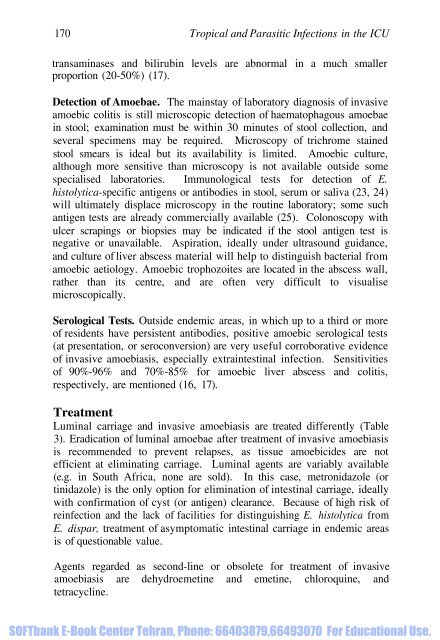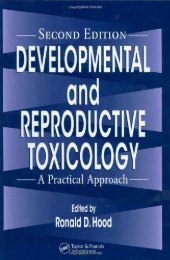SOFTbank E-Book Center Tehran, Phone: 66403879,66493070 For ...
SOFTbank E-Book Center Tehran, Phone: 66403879,66493070 For ...
SOFTbank E-Book Center Tehran, Phone: 66403879,66493070 For ...
Create successful ePaper yourself
Turn your PDF publications into a flip-book with our unique Google optimized e-Paper software.
170 Tropical and Parasitic Infections in the ICU<br />
transaminases and bilirubin levels are abnormal in a much smaller<br />
proportion (20-50%) (17).<br />
Detection of Amoebae. The mainstay of laboratory diagnosis of invasive<br />
amoebic colitis is still microscopic detection of haematophagous amoebae<br />
in stool; examination must be within 30 minutes of stool collection, and<br />
several specimens may be required. Microscopy of trichrome stained<br />
stool smears is ideal but its availability is limited. Amoebic culture,<br />
although more sensitive than microscopy is not available outside some<br />
specialised laboratories. Immunological tests for detection of E.<br />
histolytica-specific antigens or antibodies in stool, serum or saliva (23, 24)<br />
will ultimately displace microscopy in the routine laboratory; some such<br />
antigen tests are already commercially available (25). Colonoscopy with<br />
ulcer scrapings or biopsies may be indicated if the stool antigen test is<br />
negative or unavailable. Aspiration, ideally under ultrasound guidance,<br />
and culture of liver abscess material will help to distinguish bacterial from<br />
amoebic aetiology. Amoebic trophozoites are located in the abscess wall,<br />
rather than its centre, and are often very difficult to visualise<br />
microscopically.<br />
Serological Tests. Outside endemic areas, in which up to a third or more<br />
of residents have persistent antibodies, positive amoebic serological tests<br />
(at presentation, or seroconversion) are very useful corroborative evidence<br />
of invasive amoebiasis, especially extraintestinal infection. Sensitivities<br />
of 90%-96% and 70%-85% for amoebic liver abscess and colitis,<br />
respectively, are mentioned (16, 17).<br />
Treatment<br />
Luminal carriage and invasive amoebiasis are treated differently (Table<br />
3). Eradication of luminal amoebae after treatment of invasive amoebiasis<br />
is recommended to prevent relapses, as tissue amoebicides are not<br />
efficient at eliminating carriage. Luminal agents are variably available<br />
(e.g. in South Africa, none are sold). In this case, metronidazole (or<br />
tinidazole) is the only option for elimination of intestinal carriage, ideally<br />
with confirmation of cyst (or antigen) clearance. Because of high risk of<br />
reinfection and the lack of facilities for distinguishing E. histolytica from<br />
E. dispar, treatment of asymptomatic intestinal carriage in endemic areas<br />
is of questionable value.<br />
Agents regarded as second-line or obsolete for treatment of invasive<br />
amoebiasis are dehydroemetine and emetine, chloroquine, and<br />
tetracycline.<br />
<strong>SOFTbank</strong> E-<strong>Book</strong> <strong>Center</strong> <strong>Tehran</strong>, <strong>Phone</strong>: <strong>66403879</strong>,<strong>66493070</strong> <strong>For</strong> Educational Use.





